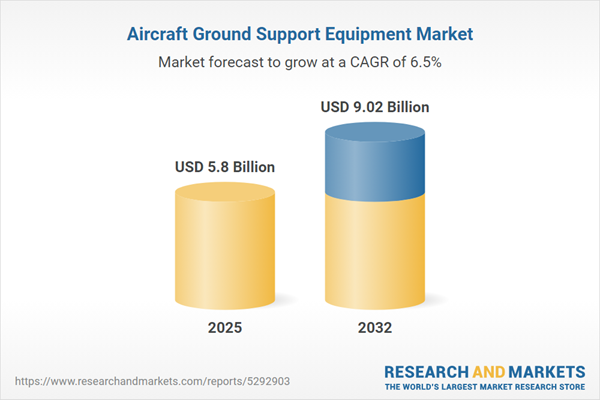Speak directly to the analyst to clarify any post sales queries you may have.
The aircraft ground support equipment market is at a pivotal moment as senior aviation leaders focus on improving efficiency, meeting sustainability targets, and ensuring compliance with evolving regulations. Rapid innovation and digital transformation are driving shifts in equipment procurement and fleet strategies across global aviation operations.
Market Snapshot: Aircraft Ground Support Equipment Market Growth
The Aircraft Ground Support Equipment Market increased from USD 5.44 billion in 2024 to USD 5.80 billion in 2025 and is forecast to reach USD 9.02 billion by 2032 at a CAGR of 6.52%. This expansion is fueled by a surge in global air travel, heightened focus on reducing aircraft turnaround times, and the swift integration of both digital and sustainable technologies. Investments in electric and hybrid equipment are on the rise, alongside supply chain diversification and deeper regional engagement across a broadening array of stakeholders.
Scope & Segmentation: Defining Modern Operational Needs
- Equipment Types: Solutions span baggage handling (automated and manual), advanced cargo loaders, catering trucks, deicing systems (towed, truck-mounted), fueling infrastructure, ground power units (auxiliary, diesel-electric, electric), lavatory service vehicles, maintenance stands, passenger boarding bridges, and diverse tugs and tractors. These solutions enable efficient servicing of multiple aircraft types.
- Power Sources: The market addresses operational diversity with off-road and on-road diesel, battery electric, towed electric, and hybrid-powered assets, meeting both environmental mandates and fleet requirements.
- End User Segments: Coverage includes major and regional airports, ground handling service providers, independent and OEM-affiliated maintenance, repair and overhaul entities, as well as military and defense airfields. Each segment has distinct needs in compliance, scalability, and service intensity.
- Distribution Channels: Sourcing alternatives encompass OEM, aftermarket, refurbishment, rental, leasing, and replacement parts, supporting both direct buyers and those seeking flexible life-cycle management.
- Platforms: Offerings include fixed, mobile, towable, and wheeled installations. This breadth allows airports and operators to adapt rapidly to changes in aircraft traffic or infrastructure demands.
- Geographies: The report delivers analysis across North America, Latin America, Europe, Middle East and Africa, and Asia-Pacific, reflecting differences in regulatory priorities, funding, and pace of electrification across key regions.
- Key Companies: Included industry players are JBT Corporation, Textron Inc., TLD NV, Tronair LLC, AERO Specialties, Cobus Industries, Ampco-Pittsburgh, BEUMER Group, Mallaghan Engineering, and Goldhofer Aktiengesellschaft, each contributing technology or service expertise within key segments.
Key Takeaways: Strategic Insights for B2B Decision-Makers
- Automation, real-time analytics, and integration of digital monitoring are enhancing ground operations with improved reliability and control.
- The shift toward electric and hybrid systems, underpinned by sustainability goals and regulatory compliance, is most rapid in established markets but is spreading to high-growth hubs.
- Fleet flexibility and equipment modularity are emerging as essential purchase criteria, enabling alignment with unpredictable passenger volumes and varied aircraft fleets.
- Regulatory influence is significant; North American and European frameworks are shaping early adoption trends, while cost-efficient, scalable models drive uptake in emerging regions.
- Strategic alliances among OEMs, aftermarket suppliers, and tech vendors are optimizing end-to-end equipment management and reinforcing competitive positioning within the sector.
- Tailored solutions to specific operational and compliance challenges are critical for stakeholders seeking to future-proof their ground support operations.
Tariff Impact: Managing U.S. Trade Policy Shifts
Recent U.S. trade tariffs on core components and assemblies are restructuring cost models and supplier dynamics in the ground support equipment space. Manufacturers are responding by reconfiguring global supply chains, accelerating local assembly, and seeking resilient material sourcing. Buyers are updating procurement processes and increasing maintenance capabilities to maintain operational standards and budget certainty. The result is increased focus on supplier diversification and the adoption of innovative domestic manufacturing approaches.
Methodology & Data Sources
This analysis is built on primary interviews with industry executives, airport operators, and regulatory bodies, complemented by secondary reviews of association reports and technical publications. Rigorous data triangulation and expert validation underpin the reliability and relevance of all findings for senior decision-makers.
Why This Report Matters: Actionable Intelligence for Industry Leaders
- Delivers practical recommendations to optimize procurement, technology integration, and fleet management within evolving market dynamics.
- Provides executives with strategic guidance on regulatory, technological, and regional influences shaping both short- and long-term business planning.
- Equips organizations with comprehensive segmentation analysis to identify high-ROI investments in electrification, digitalization, and advanced partnership models.
Conclusion
This research provides clear, actionable insights for aviation decision-makers tasked with navigating evolving operational, regulatory, and technology landscapes. Adopting informed strategies from this report will strengthen market positioning and drive sustainable growth for ground support equipment stakeholders.
Additional Product Information:
- Purchase of this report includes 1 year online access with quarterly updates.
- This report can be updated on request. Please contact our Customer Experience team using the Ask a Question widget on our website.
Table of Contents
3. Executive Summary
4. Market Overview
7. Cumulative Impact of Artificial Intelligence 2025
List of Figures
Samples

LOADING...
Companies Mentioned
The key companies profiled in this Aircraft Ground Support Equipment market report include:- JBT Corporation
- Textron Inc.
- TLD NV
- Tronair LLC
- AERO Specialties, Inc.
- COBUS Industries GmbH
- Ampco-Pittsburgh Corporation
- BEUMER Group GmbH & Co. KG
- Mallaghan Engineering Company Limited
- Goldhofer Aktiengesellschaft
Table Information
| Report Attribute | Details |
|---|---|
| No. of Pages | 198 |
| Published | October 2025 |
| Forecast Period | 2025 - 2032 |
| Estimated Market Value ( USD | $ 5.8 Billion |
| Forecasted Market Value ( USD | $ 9.02 Billion |
| Compound Annual Growth Rate | 6.5% |
| Regions Covered | Global |
| No. of Companies Mentioned | 11 |









